In case you haven’t read about it in any number of other publications: downtown Los Angeles is thriving. And especially, notably, in the two districts in between which Angel City Brewery is located—with Little Tokyo one block to the west and, to the east, the Arts District, where the micro-brew operation officially resides in a formidable, century-old, four-story former bridge-cable warehouse. In the midst of an ever-booming, California-wide beer scene, Los Angeles county itself has dozens (yes, dozens) of notable up-and-coming local breweries, each putting their own mark on their craft. One of the flagships is, without a doubt, Angel City, which was founded in 1997 and moved to the historic John A. Roebling Building in the Arts District in 2010, where they began brewing in 2012.
Sitting down at the brewery’s Public House, our guide through the beers of Angel City is brewmaster Layton Cutler. Cutler, a transplant to Los Angeles by way of Indiana and New York, has a background in chemistry (naturally), and interestingly also had a brief stint in making fireworks. (“It was fun, it was a blast, but at the same time it didn’t seem like it was gonna fit with how I wanted to grow as a person and be later on,” he admits.) He describes his first foray into serious beer-drinking during a college year abroad in Germany, consuming “fantastic” beers right from the source. He ended up studying the craft in German and Scottish schools before being hired by Anheuser-Busch and later working at a distillery in Brooklyn for a few years. He’s now been at Angel City for over a year and a half, and notes that the opportunity for experimentation is still what makes him passionate about his job.
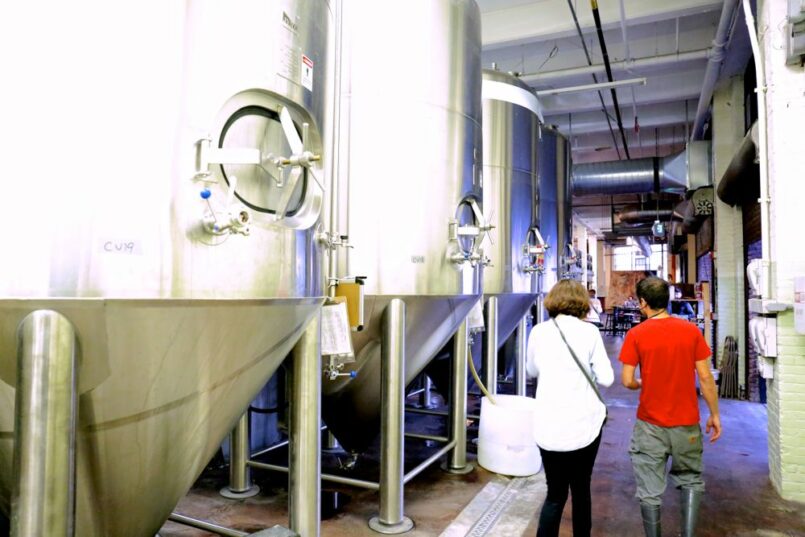 “I love going into the lab. I love trying to figure out, ‘Oh, what went wrong?’ or ‘What went right?’ or ‘Oh, OK, how can we make this process better this time or next time?’ You’re dealing with living organisms. And they have a mind of their own,” he laughs. “They’re very simple organisms, but they still wanna do what they wanna do. Their job is very simple, but it becomes complex when we’re trying to figure out what they want. But, hey, it’s a process, and if it doesn’t fit our standards, then we have to dump it down the drain. It doesn’t happen very often, but when it does, it’s a sad, sad day.”
“I love going into the lab. I love trying to figure out, ‘Oh, what went wrong?’ or ‘What went right?’ or ‘Oh, OK, how can we make this process better this time or next time?’ You’re dealing with living organisms. And they have a mind of their own,” he laughs. “They’re very simple organisms, but they still wanna do what they wanna do. Their job is very simple, but it becomes complex when we’re trying to figure out what they want. But, hey, it’s a process, and if it doesn’t fit our standards, then we have to dump it down the drain. It doesn’t happen very often, but when it does, it’s a sad, sad day.”
Today, Cutler takes us through a flight of five of the many success stories of Angel City Brewery, including a few of their flagships as well as two limited-edition experiments, discusses the history of beer-making, and explains a how an IPA gets its bite.
The Flight
So, where should we start?
Layton Cutler: I say we could probably start with the pilsner first.
Gold Line Pilsner
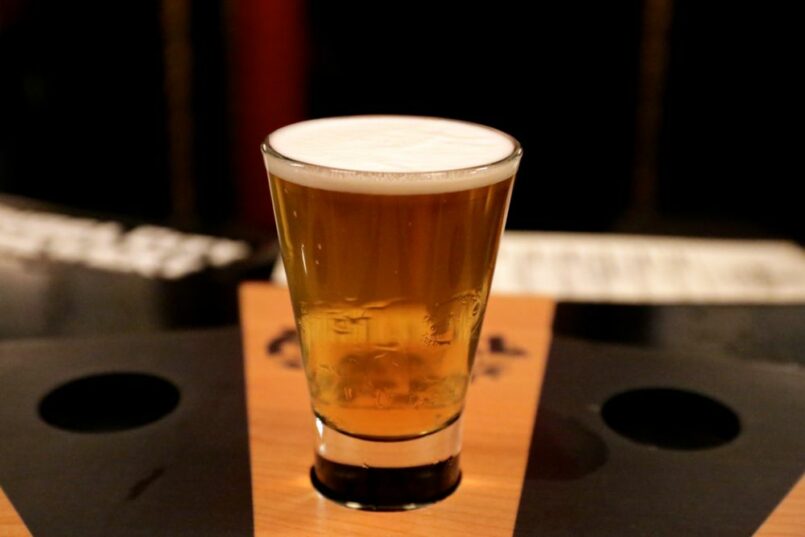 Brewmaster says: The Gold Line Pilsner, the Angeleno IPA, and the Eureka! Wit were some of the first ones that we started brewing. We wanted to make an easy-drinking, traditional pilsner beer. But also hop-forward, in a different way; a very clean, hoppy taste. In Germany, they don’t usually dry-hop. We wanted to do more of a West Coast thing, put a lot more of that hop character into it, you know, aroma and so forth. We do dry-hop this, which is very uncommon for a German or a Czech pilsner. You use hops in the boil for the bitterness, but when you dry-hop it means that you add them to fermented beer. So it’s already finished, and then we’ll dry-hop it with a variety of different hops. These are all noble hops, so it’s a little bit more spicy. But then it’s also a little bit more earthy. We get [hops] from a variety of sources. We get some that go into this [brew] straight from Germany, but we also get American-grown hops from the Northwest.
Brewmaster says: The Gold Line Pilsner, the Angeleno IPA, and the Eureka! Wit were some of the first ones that we started brewing. We wanted to make an easy-drinking, traditional pilsner beer. But also hop-forward, in a different way; a very clean, hoppy taste. In Germany, they don’t usually dry-hop. We wanted to do more of a West Coast thing, put a lot more of that hop character into it, you know, aroma and so forth. We do dry-hop this, which is very uncommon for a German or a Czech pilsner. You use hops in the boil for the bitterness, but when you dry-hop it means that you add them to fermented beer. So it’s already finished, and then we’ll dry-hop it with a variety of different hops. These are all noble hops, so it’s a little bit more spicy. But then it’s also a little bit more earthy. We get [hops] from a variety of sources. We get some that go into this [brew] straight from Germany, but we also get American-grown hops from the Northwest.
Hop talk: Are these the hops that you grow on the roof of the building?
We do grow hops. But it’s still kind of starting out. It’s only been about a year and a half. We’ve used them in one of our beers called the Rooftop Hop Ale. But it’s not a lot of hops.
 How much impact does where hops are grown have on how the beer is going taste? Is it like a wine-growing region?
How much impact does where hops are grown have on how the beer is going taste? Is it like a wine-growing region?
You mean like, “Is there terroir from the…?” Yes and no. I believe that, sometimes, if you have hops that were traditionally grown, let’s say in Europe, for English hops or German hops, when they start getting grown in the United States, then there is a little bit of difference in flavor. But for the most part, there’s not too much ’cause most of them are grown in the Northwest. So: Oregon, Washington, Idaho. They have the right temperature, and it’s perfect for growing.
All right, should we do the next one?
Angeleno IPA
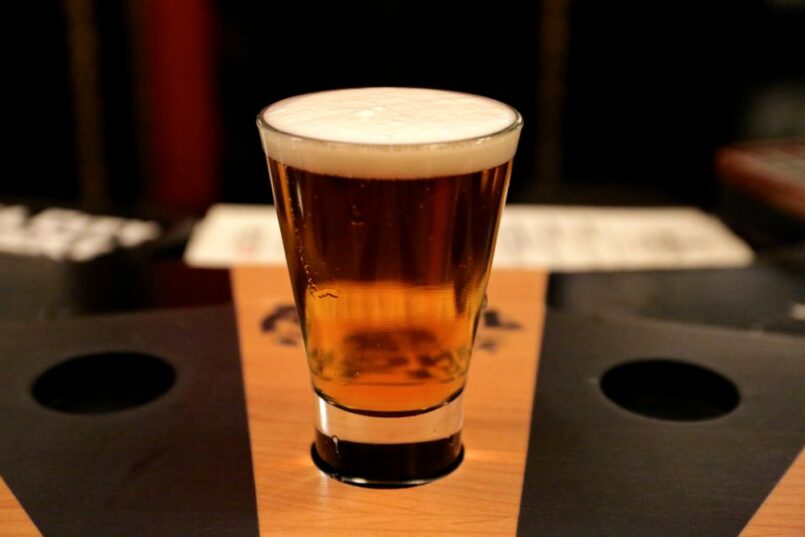 Brewmaster says: This is our other flagship. This is the one that you’re going to see pretty much throughout Los Angeles. This one is killing it for us right now. We have these brand-new tanks because we’re having to produce a lot more. And this is the one that’s taking up most of that tank space right now.
Brewmaster says: This is our other flagship. This is the one that you’re going to see pretty much throughout Los Angeles. This one is killing it for us right now. We have these brand-new tanks because we’re having to produce a lot more. And this is the one that’s taking up most of that tank space right now.
This is another beer that we dry-hop, but we’re using hops strictly grown in the Northwest for, you know, citrusy notes, bigger flavors, instead of it just being very clean. This uses honey malt, so it’s kilned a little bit more. It’s a little bit more caramelly, a bit like a graham cracker.
The difference in taste between an IPA and a pilsner is a quite a big one. So what gives an IPA that bite?
Usually for an IPA, you want to have a little bit more malt backbone to be able to compensate for that massive amount of hops that you’re putting into it.
What’s the difference in ratio of hops between this and the pilsner?
Probably a third more hops, I would say. It’s in brewing it, for making the bitterness, and also for the dry-hopping. So we’ll dry-hop it with a lot more. But you need a little bit more darker, kilned malt, so we use honey malt to give a little bit more flavor to balance out the higher bitterness.
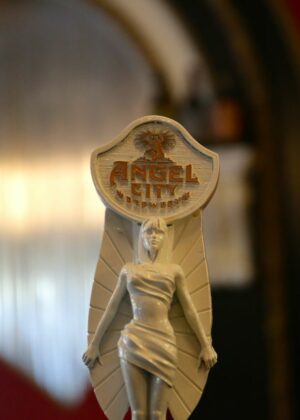 I’ve been seeing a lot of variation in IPAs on a menu: black IPAs, white IPAs, double IPAs, or “West Coast–style IPAs.” Can you explain what makes an IPA “West Coast style”?
I’ve been seeing a lot of variation in IPAs on a menu: black IPAs, white IPAs, double IPAs, or “West Coast–style IPAs.” Can you explain what makes an IPA “West Coast style”?
IPAs are an English beer, and they use more hops to make. But Americans have taken it to a whole new level, adding a lot more hops than the English would use. So if you drink an English IPA, it’s not gonna be nearly as hoppy as the American. The West Coast has a lot to do with that because the hops are grown in the Northwest, and there’s just an abundance of them. It’s a lot easier for us to get a lot more hops to be able to put into some of these beers. So when it says “West Coast,” it’s just because you’re closer to the source of getting hops.
We’ve talked about hops this entire time, but what’s malt’s contribution?
It’s very important for flavor. You have to use a base malt—our base malts are two-row malted barley and a Euro pils (to go in the pilsner). That’s where you’re getting most of your alcohol out of. But then you start adding these specialty grains in, and as we move along then we’ll be able to taste some of them. Especially with darker beers—stouts—they’ll use highly kilned malts. They almost taste like coffee in a way, almost burnt. So you’re not gonna get any alcohol out of it because they don’t have anymore sugar or starch. They’re just gonna have the dark flavor, and then when it ferments, you start getting into dark fruits and raisins, plums, things like that.
OK, so next we’re gonna move to…
Are we doing this by color?
Just to not destroy your palate. Normally you want to start out on the lighter side and then you can kind of move up because then you’ll be able to get a lot bigger flavors.
Pomegranate Saison
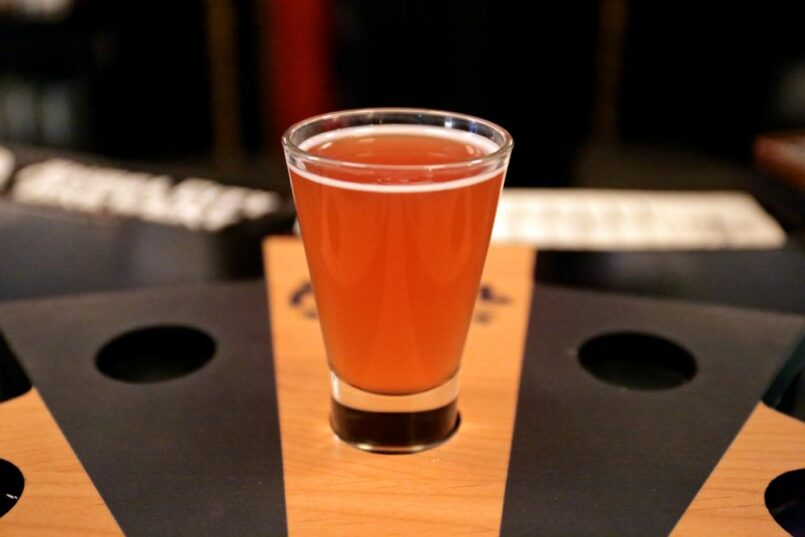 Brewmaster says: So this is the Pomegranate Saison. This uses a very different yeast. The pilsner uses a traditional pilsner yeast, the Angeleno uses an American ale yeast. This is a saison yeast and it’s Belgian. It has more funky flavors because that’s how it wants to ferment. It wants to ferment a lot warmer. It wants to produce a lot more of these higher alcohols… It’s a little bit more higher-octane, I would say. And then we add pomegranate to the boil and also in secondary fermentation. That brings our alcohol up a lot more. Like, this is 8.3 percent. And that’s why we put it in ten-ounce glasses.
Brewmaster says: So this is the Pomegranate Saison. This uses a very different yeast. The pilsner uses a traditional pilsner yeast, the Angeleno uses an American ale yeast. This is a saison yeast and it’s Belgian. It has more funky flavors because that’s how it wants to ferment. It wants to ferment a lot warmer. It wants to produce a lot more of these higher alcohols… It’s a little bit more higher-octane, I would say. And then we add pomegranate to the boil and also in secondary fermentation. That brings our alcohol up a lot more. Like, this is 8.3 percent. And that’s why we put it in ten-ounce glasses.
Saisons are frequently paired with fruit flavors, but how’d you guys decide on pomegranate?
We just thought that it would be a fruit that would compliment it well. Make it more tart, but then also balance out a lot of the estery profile. The more fruity flavors, the fruity aromas, come off during fermentation because of the specific yeast. If you drink a saison, it’s gonna be a little bit spicy just from the yeast—just from fermentation—but it’s also gonna be a little bit more fruity because it’s gonna make higher alcohols and esters. Yeast typically just wants to make ethanol, which is alcohol. But then yeast also starts making these other alcohols that are a little bit longer chained, they’re a little bit more complex, and they’ll give very, very different flavors.
For the Sake of Ale

Brewmaster says: So the next one we’ll try is the sake beer. We were gonna call it Sake Beer, but the government wouldn’t let us because it’s not technically a sake. So we called it For the Sake of Ale. Most of the brewers and I go over to Little Tokyo and eat lunch constantly. So, we’re influenced by them, eating fantastic Japanese food—ramen places, yakitori places, sushi spots. We wanted to say, “Hey, we like what you guys are doing and hopefully you guys will like what we’re doing.”
This took about two and a half months to brew because we did a really long, cold fermentation on it. We used a ton of rice, because that’s what traditionally goes into sakes, but we also did a traditional sake fermentation in the very beginning. To make sake, they use koji mold. And because rice doesn’t have its own enzymes to break down the starch, then they have to inoculate steamed rice with this stuff called koji mold or aspergillus oryzae. We did a small fermentation with that where the koji mold actually inoculates and breaks down the starch in rice into fermentable sugars. Then after, we brewed beer on top of that and did a traditional brew with this, like, rice mash, but then also the brew mash—the barley mash—and then we added some hops to it. Then we let it ferment for about a week or so and started adding even more rice brews to it. That’s traditionally what sake breweries do. For sake to get up to eighteen percent, you really have to coddle and treat your yeast correctly. You have to make sure that it’s very happy. Cause if it gets overwhelmed by the amount of sugar in there, then it doesn’t want to keep fermenting. So that’s why you make these small additions of more rice to get it to make sure that your yeast is very happy and wants to keep making more alcohol.
 I have to admit that I do not like sake very much. I try to avoid it a little bit. This is very good.
I have to admit that I do not like sake very much. I try to avoid it a little bit. This is very good.
It was an experiment for us. I made a trial batch, and it tasted very good. So we tried a big batch, and along the way the whole thing was an experiment. I mean, we’re having to say, “Well, we’ve never done this before. When should we add this, when should we add that?” They gave me a lot of control over it, and I’m very happy with it.
This is kind of your baby.
It is, yeah. [Laughs.] It kept me up late at night trying to think about, “OK, what should I do?” Because if it was undrinkable, then that would be an expensive beer to dump down the drain. It’s very technical.
Everything you’ve spoken about really demonstrates how much of a scientific process brewing is. You mentioned that you’ve home-brewed sake at home before, but how much of a learning curve was there here?
Well, I understand the processes, but at the same time, you’re using living organisms. I’m using a mold, I’m using a sake yeast, I’m using things that I don’t know how they’re gonna react. You have to try to think like them—they are simple-celled organisms, but you have try to think like them and say, “How would you want to be treated? What would your perfect environment be to give us the flavors that we want?” It’s not easy. We have to test it on a regular basis to make sure it’s moving the way we want it to move, and I think it did. I think it came out as best as possible.
Dark Rye Lager
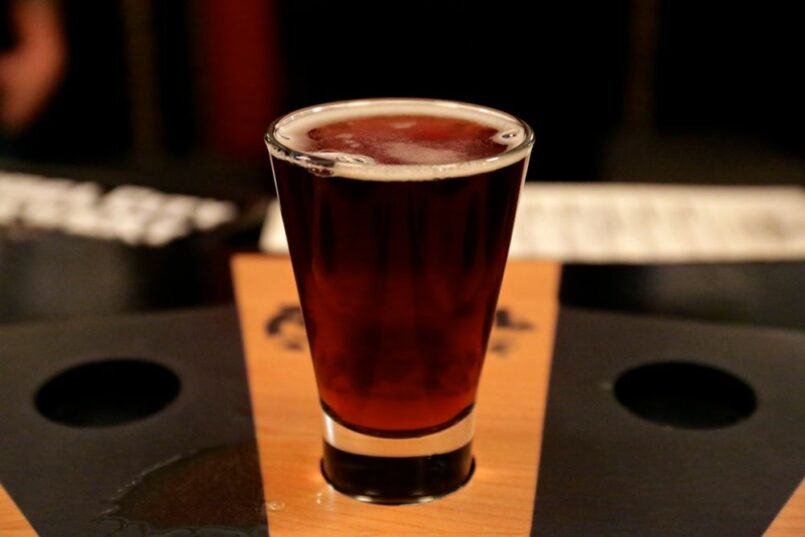 All right, so this last one I have to say I’m dreading a little bit because I never do too well with the brandy barrels. These are always quite heady.
All right, so this last one I have to say I’m dreading a little bit because I never do too well with the brandy barrels. These are always quite heady.
Yeah, so this is 11 percent. This is the Dark Rye Lager.
This will not be finished. [Laughs.]
We’ve done this a few times, aged the beer in different barrels. This is the third incarnation. The last one was aged three months in bourbon barrels. This is six months in brandy barrels. Bourbon barrels only get used one time [by a distillery]. And then they get sold throughout the world. They go to Scotland, they go to a lot of microbreweries in the United States. But these brandy barrels have been used multiple times. So a lot of the—“virtue” is what they call it—flavor has been stripped out of the barrels, somewhat. Like scotch barrels, they’ll re-use them multiple times, and then at some point they’re just not going to be able to give that oak flavor that they want. So we wanted to make sure that the barrels pick up a lot of the brandy, but also pick up that wood flavor, too. We wanted to give the beer a long enough time to mature and make sure you can taste the brandy. Not just throw it in there, pick up a little bit of brandy. We want you to say, “Wow, I can taste those grapes, I can taste the distilled spirits that went into this.” So, you can really taste the dark fruits in this beer.
 I really like the aftertaste.
I really like the aftertaste.
Right, a lot of it’s from the brandy, but a lot of it’s also from the beer itself because we’re using darker grains—and a fermentation bit goes on for a while with the darker grains—then you pick up a lot of the dark fruit flavors.
It’s very caramelly.
Yeah, plums, a little bit of raisin, prunes, you know, but then the brandy also comes in. But it’s a very big beer. I just call them “big beers” or “little beers.” Big beers are the ones for when you’re sitting by a campfire, or a “winter warmer,” you could call them.
In addition to the flagship beers, at any given point, how many more off-the-wall ones are you guys working on at a given time?
It depends. Usually, right now, we’re keeping up with demand, so we’re doing the flagships pretty much four days a week. But then we’ll find time to start throwing in these specialty batches. And they’ll also go in the Public House, too. There’s a lot of collaboration. It’s not just, “You brew this beer, you brew that beer.” We collaborate and everybody puts in their own ideas. FL
Angel City Brewery is located 216 South Alameda Street in Downtown Los Angeles. The public house is open Thursday through Friday from 4 p.m.–12 a.m., Saturday from 12 p.m.–12 a.m., and Sunday from 12–10 p.m.
Check AngelCityBrewery.com for tour times and updates on what beers are available.







